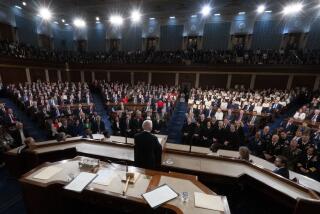Making Postwar America a Land Fit for Heroes
With the New World Order still in combat in the Persian Gulf, itâs not too early to think about the New Domestic Order.
Itâs time to plan for the postwar economy, in which a major focus will be on economic development within the United States.
For more than a year, public attention has been drawn to Eastern Europe, the Middle East and beyond. But now influential voices are saying, pay attention back home.
Thatâs where a whole litany of problems need solving--unconscionable high school dropout rates, 25% illiteracy in the work force, crumbling roads and water systems, decaying environment, lagging productivity.
Calls for action take on added force when they note that the poor and less advantaged of American society are disproportionately represented on the front lines in the gulf. A wise nation would see to it that the country they return to is indeed a land of opportunity.
So, even with a month of war before us--if weâre lucky--the time is now to make a few plans.
History provides a great example. In 1942, when World War II had three years to go and German bombs and rockets were raining on England, a committee of the British government sat down to plan social reforms for the postwar--better housing, health care, schooling and many other things. The background was that after World War I, Britain had gone back to business as usual and neglected social reform. Feeling guilty in the 1940s, with its people fighting again, the British government set out to create âa nation fit for heroes.â The results after 1945 were reforms to lift the living standards and productivity of the British people.
Now, America is not Britain--but lately words such as âunderclassâ have been creeping into its vocabulary, where they donât belong. Whatâs to be done?
âWe need educational and economic development of disadvantaged people,â writes Shelby Steele, author of âThe Content of our Character,â a new book about race relations in America. Steele offers few specifics on how to do that, beyond nodding like many others at the success of the Head Start program for disadvantaged children. But he has a point.
In simpler and poorer times we did something. In the 1930s Depression, we put people to work in the Civilian Conservation Corps and the Works Progress Administration. The wages were low, the programs had flaws and were not a long term answer. But they put 5 million people to work.
Similarly, in those times the Reconstruction Finance Corp. made loans to struggling businesses and gave a transfusion to the economy. And if that sounds like ancient history or just big government talk, youâll soon hear more of it from corporate boardrooms. One of the nationâs leading bankers recently invoked the name Jesse Jones, the Texas banker who ran the 1930s RFC. âWe need somebody like Jesse,â said the 1990s banker, âto get money moving in the economy.â
Two questions: What will the money move on? And where will it come from?
Two prime targets for the money will be infrastructure and education, because the needs are pressing and because each offers a measurable payoff.
Infrastructure demands are tremendous. State and municipal officials estimate that public spending must double to almost $150 billion a year just to bring roads, bridges, water mains and such up to proper standards and cope with new growth.
That large an increase in public spending is just not going to happen, but one-half to two-thirds of the estimate would pump a lot of money through the economy. And pay off in productivity gains. âPublic investment in infrastructure inspires private investment,â says economist David Aschauer, of the First National Bank of Chicago. He is referring to efforts such as the Interstate Highway System, begun in 1956.
The total cost of the Interstate was $110 billion--$100 billion from the Federal government, $10 billion from the states. It not only made jobs; it reduced transport costs and thus raised productivity, and it spawned an avalanche of investment.
A 1990s sequel to the Interstate could be a fiber-optic telecommunications network for homes and businesses. The ultimate payoff is incalculable.
Education reform is a numbingly frustrating subject. Nobody quite knows what to do, only that cutting the losses weâre suffering today would be like paying off the national debt. âEvery high school drop out costs $4,600 a year in higher social spending and lost taxes,â says Kay R. Whitmore, the chairman of Eastman Kodak. âOver a lifetime, each class of dropouts costs the country $240 billion.â
When problems are put in cold cash like that, itâs a sure sign that major efforts will be made.
Yes, but whereâs the money to come from? Everybodyâs favorite source is the defense budget, and for sure it will be cut. Watch for defense spending to fall 20% or roughly $60 billion in the year after the war, maybe more later. Yes, U.S. high-tech weapons are wondrous, and the armed forces are superb. And the weapons will be kept up-to-date and an armed forces maintained after the gulf war. But numbers and expenditure will be reduced. When the gulf war is over, the U.S. wonât soon again go into action overseas.
And beyond money freed up from defense, there will be public investment. Count on it, the nation that found the money to fight for freedom overseas, will find a way to pay repair bills for the good society here at home. Start planning now.
More to Read
Sign up for our Book Club newsletter
Get the latest news, events and more from the Los Angeles Times Book Club, and help us get L.A. reading and talking.
You may occasionally receive promotional content from the Los Angeles Times.








